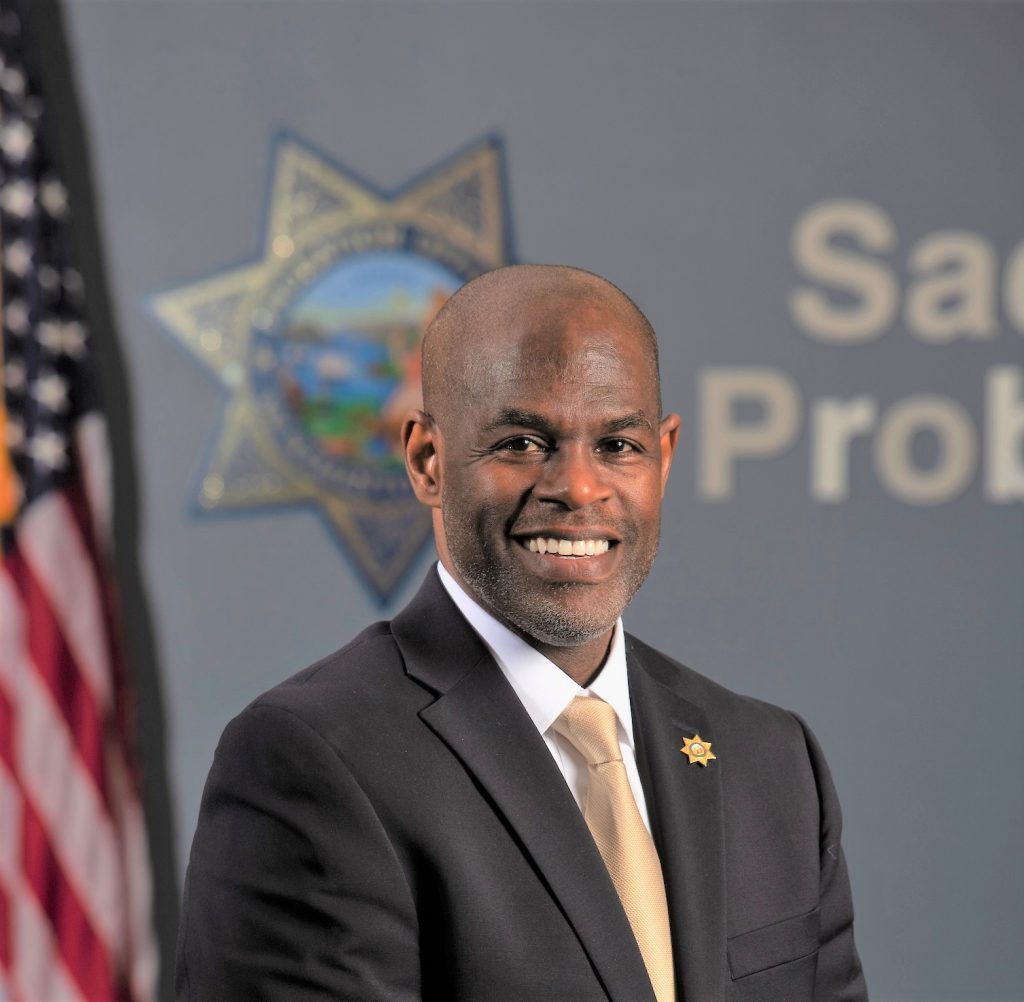Marlon Yarber was born and raised in Stockton. His personal experiences there, in large part, he says, helped shape his career: His father was career military and went on to work for 20-plus years at what was then called the California Youth Authority. Yarber also grew up with extended family on both sides of the law, as well as a close-up view of gang activity in his hometown. The end result? Yarber has long questioned the system, particularly why so many Black people end up arrested and incarcerated.
He started his professional career running a mentoring program, then as a juvenile probation officer, where he recalls wearing khakis and a polo shirt and carrying an old bag, a cell phone and a clipboard to take notes on. His caseload would double almost immediately, but it was there he learned his most important job was to listen—the strategy new probation officers are taught today.

He also learned that justice-involved kids’ issues are complex: mental health, substance use and abuse, not attending school, absent families—or family who are criminals themselves. So to really see change, he realized then, probation must do more collaborative work—the very multidisciplinary team approach that is in place now. He also saw the only real way to have a successful program, no matter what the research says, is to have the right people in place.
He brought these ideas with him as he began to influence policy, first as a criminal justice specialist and supervisor of a gang suppression unit. After a stint in Yolo County, he became the Assistant Chief of Sacramento Probation in 2013, and was appointed Chief here in 2021.
Marlon, I really appreciate you meeting with us today and doing this deeper dive into a discussion about the probation department. How does your personal life and policy work, together, translate into your vision for positive change?
I think it’s all of those experiences that have really helped shape what I think is the future for the department. With (former Chief) Lee Seale able to transform and really change the culture of the department here in Sacramento specifically, now I think my interest is doing more to engage the public.
Sometimes it’s uncomfortable because the public will press on us, but I expect them to. People have an interest in something that taxpayer dollars essentially supports and we should be transparent. We should be talking about what we’re not good at and how we could get better.
Can you think of personal examples of people that have been examples of positive change?
One example I can think of very clearly is a gentleman who we worked with in our Adult Day Reporting Center. He was 60 years old, never had legitimate employment, had a murder in his background from another state. He winds up here in California, touches the system and ends up (incarcerated). He gets out, we assess him, connect him to the treatment modalities, the programming at our Day Reporting Center. He completes that, completes his education for the first time ever—he had never, at 60, completed his GED. He goes through the vocational training program with Northern California Construction and Training, completes that and obtains his first legitimate job ever.
He winds up in the construction field … in the Bay Area. We realize he’s got no transportation. He’s lobbying others for rides to get back and forth every day. So as part of the graduation, County Office of ED and NCCT pulled some funds together to purchase him a very small vehicle to help with the transition and transportation back and forth.
So when I think about that, that’s a game changer. It not only changes his life—obviously he’s a different person—but it changes his children’s lives. It changes their trajectory in life.
It changes the way the public thinks about him, and obviously the way he thinks about himself. That’s what it’s about. There was nothing soft about our response. Oftentimes when we talk to our clientele, they’ll say ‘Put me back in prison. I don’t want to come to these classes. This is hard. I have to show up every day. I have to talk about my issues, I have to talk about the trauma I’ve had. I have to deal with the fact that I haven’t seen my kids, being absent as a parent.’ But those classes, the treatment, the interventions really can change the way we go about public safety, in my mind, that truly is public safety.
Well, that’s really beautiful, Marlon. Can we talk about what you’re doing with youth?
With youth, it’s even more important that we pursue that balance. I talk about accountability and opportunity. When I’m speaking in a big group, I usually call out if there isn’t any one of us as adults who hasn’t made a mistake or done something that we’re embarrassed about, don’t want to tell the rest of the folks in this room about—but we recognize all kids make mistakes. And the idea there is that we hope that it’s not something they can’t come back from.
They will certainly move on in life. The brain science tells us like they will continue to make mistakes up until their mid-20s, if not further. So for us it’s about really addressing the needs that we know all youth have. All youth at the very basic level need discipline and love.
They need someone that cares, but they also need to know where the guardrails are. They have to know this is too far out of bounds, or this is within reason. Whether it’s youth who are in our care and custody at the Youth Detention Facility, or youth in the community, we try to provide that opportunity for them.
So when I think about examples, there’s a young man that earns his way to the state’s care and custody, at the Division of Juvenile Justice. But he realizes this is not the end of the world and that he is getting out at some point. He pursues high school education, completes that, enrolls and completes college education, and then becomes the business owner later, who can turn back to us, and say, ‘Hey, look where I’m at now, and I appreciate all that you all did for me. Because without you, I might not have understood the opportunity that I had. And now I’m here and my neighbors just think I’m the average Joe. But I’ve got this history and I’d love to give back by making jobs available for youth in the system.’
For anyone who thinks that’s an easy route out, it really is not when you talk to the clientele. They would much rather just do the time, be on with their lives, and get back to the things (they’ve been doing)—that’s easy. But working with the court and our court partners, directing this person to complete treatment or counseling, to enroll in school, and to complete the behavioral health treatment program, those things we know really are more conducive to better outcomes and obviously lead to better public safety.
Chief Probation Officer, Marlon Yarber
One of the concerns is being soft on crime. What do you want to say about that?
It’s the insanity explanation, right? As a system, law enforcement and corrections, we’ve done the same thing over and over, for decades. Arresting people, locking them up, observing the high costs of incarceration, but then being disappointed with the outcomes when folks get back to the communities that we all share—though we expected something different to occur. So the insanity part of that argument is by continuing to do that same thing, and still just being upset by the poor outcome, the behaviors are not changing. We have to think about the way we go about our business in a different fashion.
It’s really about getting much smarter on crime and thinking through what would actually lead to a better outcome, both for that individual but also for the rest of the community. Probation’s role is really one where we’re directly focused on the rehabilitation of all those who come into contact with us.
Now, that term itself—rehabilitation—connotes that the person had some things first, the “re” part, or doing again. Many of our clients have never really had anyone explain where those guardrails are or provide that love.
For the youth who are in our care and custody, we look at that as an opportunity to provide those two things, but then going much further and really trying to address what I say are the shortcomings of that old traditional system: provide the things that youth need. We’ve been fortunate to work with the Sacramento County Office of Education. We’ve had college programming, vocational programming—culinary and construction—in our facility for years. We’ve got a great relationship with behavioral health, other local treatment providers—an army of community-based organizations—all of whom have been working with us side-by-side in our facility and in the community for years
For anyone who thinks that’s an easy route out, it really is not when you talk to the clientele. They would much rather just do the time, be on with their lives, and get back to the things (they’ve been doing)—that’s easy. But working with the court and our court partners, directing this person to complete treatment or counseling, to enroll in school, and to complete the behavioral health treatment program, those things we know really are more conducive to better outcomes and obviously lead to better public safety.
One (thing) we’ve been working at now is the Division of Juvenile Justice Realignment.
The state is closing its doors, its facility doors, and that means kids who locally would’ve gone on to their care and custody are now staying with us. But also there’s a returning population in custody coming back to us. And so my goal there really is to ensure just the best services possible.
Because as I say to even my law enforcement partners: All of those kids are going home. They’re all coming back to a neighborhood near you and me. And so it’s on us to figure out how to do that in the best way possible: education, vocation, treatment, supports, connectivity to positive adults, reduction of gun violence, better decision-making. We have to be all hands on deck with regards to that transition and re-entry.
The probation department is connected with so many different organizations in Sacramento. Can you give an example of the partnerships that help you achieve positive change?
You’re absolutely right. There’s a graphic that we use sometimes, and probation is the hub of this large puzzle. We really pride ourselves on being generalists or experts on many things: Some people feel that Probation wears many hats but I always say we really only wear one hat: probation. It just means we know something about everything that’s going on in the system.
A partnership we’ve had that’s stood the test of time, even with transitions in leadership, is the Sacramento County Office of Education, Dave Gordon and his team; we’ve had just an incredible relationship. I often will point to the person that they identified as the principal of our high school and junior high in our facility, Mrs. Barbara Modlin, as being the linchpin.
Working together, we realize that many of the youth come to us deficient in credits and need extra supports. SCOE’s very quick to provide a transition specialist to ensure that when youth transition out of custody and back to the community, all the credits that they’ve earned rapidly while with us get back to their home school as quickly as possible, and that they’re not lost as it relates to re-enrollment at that school site.
We’ve also worked with SCOE, well in advance of Division of Juvenile Justice Realignment, and we were early in the game providing college education in custody for our youth. We recognized many youth completed their high school equivalencies, but then there’s downtime where youth aren’t really doing anything. So we quickly said, let’s connect them to remote learning opportunities or bring professors into the units to actually deliver entry college courses—intro to sociology, English, college study habits, etc.
But not every kid can see themselves completing a degree or an advanced degree … so the CTE, or Career Technical Education pathway, became an added bonus. We’ve been very fortunate to implement both the culinary program and Northern California Construction and Training in the facility. The picture I always share when we’re walking people through for a tour, in this unit that we’ve dedicated now for those programs, you have power tools, you have saws and hammers, nail guns, you have knives. For us, it’s a game changer when we think about the culture of our work.
We are very careful about which youth, ensuring that youth are invested, have earned all their levels, are respectful, participate, have positive attributes themselves, and want to engage and learn. But also our staff are supportive, engaging and understand that we’re going to take a chance and see how this works. We’ve had nothing but great results from connecting youth to those opportunities in custody. We’ve had youth in each of those programs say, I think I want to be a chef. I think I want to go to school. I think I want to continue this…
I had a kid yesterday, at our high school graduation, say he wants to be an engineer. He’d previously done some roofing work, then completed the NCCT programming and now thinks: ‘Oh, I actually want to go do this for a living.’ Those for me are really just clear examples that we’re doing something right here.
We have new leadership in both the DA and Sheriff’s offices. Can you talk a little bit about your relationship with those two departments and how things should unfold?
So, first let me say I’m very excited about the changes in both of their departments, particularly with the elections. With me not being an elected, there is a different way that I engage. Obviously, they’re elected. They can do and say some things that are often times bolder.
I happened to be with the DA this morning. Really, really interested as he’s expressed support and motivation to help with addressing gun violence in the county. Something that’s obviously on my radar as we see the after-effects or results of gun violence.
Both the victimization, but also youth and adults winding up in custody for those types of acts. I’m curious to see ultimately where we will be a year from now, but (it’s) very much a promising partnership on how we can better work together to involve community-based organizations, involve the court, and also defense counsel to implement what I allude to as better public safety policy. His messaging around prevention and work with the community is something that we share.
As it relates to the sheriff, … it’s rewarding to see his own transformation, from sheriff’s captain, to city elected, to state elected, member of the legislature, and now back to sheriff.
We are partnering on so many different levels—both behind the scenes … but also partnerships in the community. His efforts are squarely pointed at homelessness and how he can work to address and alleviate some of those issues. We can absolutely get behind those types of efforts.
And I would be remiss to not also touch on the efforts to try to alleviate some of the concerns with regards to the jail population. Probation is the historic or traditional alternative, if you will, and so really thinking through which population or subset of the population is right and most appropriate for jail helps them and their challenges with overcrowding and conditions. We’ve got probation officers embedded along with sheriff’s deputies on multidisciplinary or multi-agency task forces. Again, I appreciate and look forward to that continued partnership.
You’re a large employer. How many people work for the department?
We’ve got roughly 700 staff. About a 100 of those are administrative professionals. The other are our sworn officers. I think we’ve got the best department in the state, and it’s largely due to the staff that we have hired. I’m always amazed I can come up with the big hairy idea, the crazy idea and the staff says, ‘Not sure about this part, but let us see what we can do.’ And it’s better than what I conceived or just threw off the cuff. It’s always very rewarding to just see the level of buy-in and implementation. The creativity astounds me.
Obviously there’s been a sea change in thinking about probation, in which the 700 members live in on a daily basis. So what’s it like for them to be really focused on positive change and doing the implementation of the deep dive with individuals and stuff, as opposed to being much more of a rule enforcer?
The work’s actually become harder. We have to have better trained, more highly skilled, well educated staff to help implement whatever the treatment modality or interventions might be. We need people from all walks of life. We always like to say, in our recruitment message, have you ever been a member of a team, like to coach or teach, do you counsel, do you volunteer?
You can apply all of those tools to the field of probation because we need all of those abilities in order to be successful in the mission.
Do you have recruitment needs right now?
Yes. Unfortunately. A few things are at play, whether it’s the social justice efforts tied specifically to like the George Floyd death during the height of the pandemic or the pandemic itself more generally. It’s really challenged us, as we’ve seen in many industries, with getting people to come and accept what are great paying truly rewarding and satisfying jobs.
My messaging is always that our No. 1 priority right now is recruitment—getting as many people who are qualified, able, interested in wanting to do this type of work.
I also make myself available for recruitment efforts and whenever I’m speaking to a group, I say, ‘If you’ve ever thought you wanted to give back, there’s no better place to help implement better solutions than to work in the probation department.’ We are about positive change but we’re also about balancing that accountability and opportunity.
The interaction and ability to kind of tell this story is truly appreciated because I think we have to begin talking about probation as a career path for elementary school kids. We get kids that say I want to be a cop. I want to be a firefighter, I want to be a teacher. I want to go play football.
But you never hear a kid ever say they want to be a probation officer, unless they’ve had a family member who was an officer. Or they had a family member who was on probation and the experience was positive. Aside from that, there’s really little exposure, and some of that’s due to the fact we work in the shadows.
A lot of the work is confidential and we don’t go about talking about our clientele often. But we have to begin messaging earlier and to the public: This is a great place and truly satisfying work where you can give back to your community and also help with regards to public safety.






Be the first to comment on "Sacramento County’s Chief Probation Officer, Marlon Yarber, discusses his department’s goal of achieving positive change"